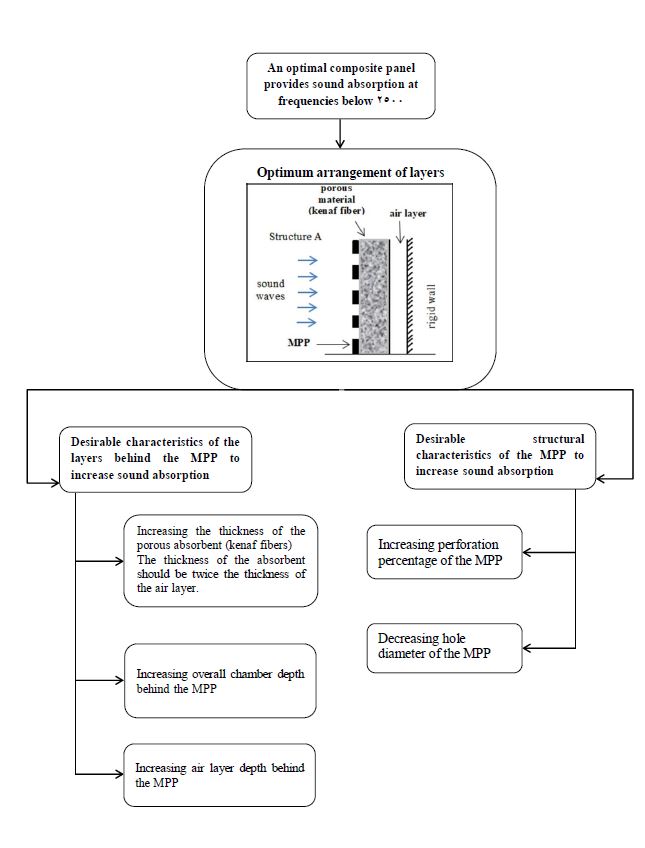Volume 12, Issue 4 (12-2022)
J Health Saf Work 2022, 12(4): 872-894 |
Back to browse issues page
Download citation:
BibTeX | RIS | EndNote | Medlars | ProCite | Reference Manager | RefWorks
Send citation to:



BibTeX | RIS | EndNote | Medlars | ProCite | Reference Manager | RefWorks
Send citation to:
Hashemi Z, Monazzam Esmailpour M, Nasirzadeh N, Farvaresh E, Beigzadeh Z, Salari S. Estimation of Sound Absorption Behavior of Combined Panels Comprising Kenaf Fibers and Micro-Perforated Plates below 2500 Hertz. J Health Saf Work 2022; 12 (4) :872-894
URL: http://jhsw.tums.ac.ir/article-1-6776-en.html
URL: http://jhsw.tums.ac.ir/article-1-6776-en.html
Zahra Hashemi1 
 , Mohammadreza Monazzam Esmailpour2
, Mohammadreza Monazzam Esmailpour2 
 , Nafiseh Nasirzadeh2
, Nafiseh Nasirzadeh2 
 , Ehsan Farvaresh2
, Ehsan Farvaresh2 
 , Zahra Beigzadeh2
, Zahra Beigzadeh2 
 , Samaneh Salari *
, Samaneh Salari * 
 3
3

 , Mohammadreza Monazzam Esmailpour2
, Mohammadreza Monazzam Esmailpour2 
 , Nafiseh Nasirzadeh2
, Nafiseh Nasirzadeh2 
 , Ehsan Farvaresh2
, Ehsan Farvaresh2 
 , Zahra Beigzadeh2
, Zahra Beigzadeh2 
 , Samaneh Salari *
, Samaneh Salari * 
 3
3
1- Department of Occupational Health Engineering, School of Public Health, Behbahan University of Medical Sciences, Khuzestan, Iran
2- Department of Occupational Health Engineering, School of Public Health, Tehran University of Medical Sciences, Tehran, Iran
3- Department of Occupational Health Engineering, School of Public Health, Tehran University of Medical Sciences, Tehran, Iran ,salari-s@razi.tums.ac.ir
2- Department of Occupational Health Engineering, School of Public Health, Tehran University of Medical Sciences, Tehran, Iran
3- Department of Occupational Health Engineering, School of Public Health, Tehran University of Medical Sciences, Tehran, Iran ,
Abstract: (1121 Views)
Introduction: Natural materials are more efficient and attractive than synthetic materials. In this study, the sound absorption behavior by natural kenaf composite and Micro-Perforated Panel (MPP) at low and medium frequency region was investigated.
Material and Methods: Initially, the results of kenaf fibers with a thickness of 10 mm were validated by the Finite Element Method (FEM) based on COMSOL Multiphysics 5.3a. The studied combined panel is consisting kenaf fibers with micro-perforated plates and an air layer. This study examined the varying arrangement of the behind layers of the MPP, the different thickness of the layers, and the structural parameters of MPP. The structure with the best absorption coefficient was chosen for the following stage and was considered constant at each stage.
Results: The arrangement of composite layers indicated a strong direct effect on the sound absorption performance; as we discovered that kenaf fibers behind MPP led to better performance in frequencies below 2500 Hz. In addition to the chamber depth behind the MPP, the material and macroscopic properties of the layers, at the same depth, are also important determinants of the exact point of the resonant frequency. Furthermore, configurations in which air layer depth is more than the absorption layer, with the same diameter (hole) and depth (chamber), maximum resonant absorption peak is achieved.
Conclusion: Low-frequency sounds can be successfully dissipated by combining MP plates with kenaf fibers as reinforcing absorber in combined panel. In general, choosing the optimum structural parameters (Composite panel according to structure A with 0.5 mm hole diameter and 2% perforation percentage) allows a significant absorption at a specific frequency range. In this context, the use of numerical estimation to assess the sound absorption behavior can be meticulously substituted the difficult methods and laboratory costs.
Material and Methods: Initially, the results of kenaf fibers with a thickness of 10 mm were validated by the Finite Element Method (FEM) based on COMSOL Multiphysics 5.3a. The studied combined panel is consisting kenaf fibers with micro-perforated plates and an air layer. This study examined the varying arrangement of the behind layers of the MPP, the different thickness of the layers, and the structural parameters of MPP. The structure with the best absorption coefficient was chosen for the following stage and was considered constant at each stage.
Results: The arrangement of composite layers indicated a strong direct effect on the sound absorption performance; as we discovered that kenaf fibers behind MPP led to better performance in frequencies below 2500 Hz. In addition to the chamber depth behind the MPP, the material and macroscopic properties of the layers, at the same depth, are also important determinants of the exact point of the resonant frequency. Furthermore, configurations in which air layer depth is more than the absorption layer, with the same diameter (hole) and depth (chamber), maximum resonant absorption peak is achieved.
Conclusion: Low-frequency sounds can be successfully dissipated by combining MP plates with kenaf fibers as reinforcing absorber in combined panel. In general, choosing the optimum structural parameters (Composite panel according to structure A with 0.5 mm hole diameter and 2% perforation percentage) allows a significant absorption at a specific frequency range. In this context, the use of numerical estimation to assess the sound absorption behavior can be meticulously substituted the difficult methods and laboratory costs.
Keywords: Micro-Perforated Plate (MPP), Kenaf natural absorption, Combined panel, Low and medium frequencies
Type of Study: Research |
Received: 2022/12/26 | Accepted: 2022/12/31 | Published: 2022/12/31
Received: 2022/12/26 | Accepted: 2022/12/31 | Published: 2022/12/31
Send email to the article author
| Rights and permissions | |
 |
This work is licensed under a Creative Commons Attribution-NonCommercial 4.0 International License. |





